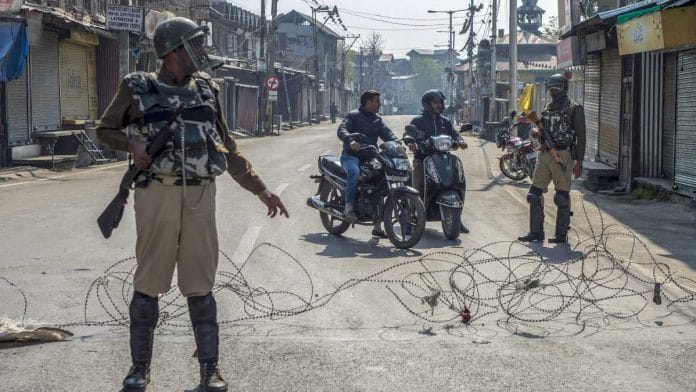Four incidents of sniping in Kashmir Valley has given rise to a new security fear which puts not just police and Army personnel at risk but also politicians.
New Delhi: Suspicions that militants in Kashmir may have turned to sniping have stoked new fears in a region already in the grips of panic and volatility.
If snipers are actually on the loose, it’s not just the security personnel on the ground that are at risk, but also the police and Army brass as well as politicians, say experts. American president John F. Kennedy, for example, was shot dead by a sniper in 1963.
Snipers, shooters who are trained and specialise in hitting targets with modified rifles from incredibly long distances, have allegedly struck in Kashmir four times since September.
The first such attack took place at Newa in Pulwama on 18 September, when a CRPF trooper was injured. Then, on 21, 25 and 27 October, sniper fire killed three security personnel. The Pakistan-based terror group Jaish-e-Mohammad (JeM) claimed responsibility for three of these attacks.
According to sources in the Border Security Force (BSF), they had found photos of new sniping rifles on social media profiles associated with militants.
‘Precise’
Lt Gen. Syed Ata Hasnain (Retd), a former GOC of the Srinagar-based 15 Corps, described sniping as “precise”.
“Sniping can be done just by having an AK-47 and fitting it with an effective long-range night sight,” he told ThePrint. “Of course, specialist sniper rifles are much more effective but the ranges they can fire at are unavailable in built-up areas,” he said. “Here, at night, we are looking at approximately 300 metres of clear sight.
“Silencing technology is also available to suppress what is called the ballistic rack of an AK-47,” he said. “It will be that much more difficult to locate the direction of fire and take counter action.”
Asked about the level of training required, Hasnain said it was more of a need for “the really professional ones”.
“At a range of 200-300 metres, with some aid from the night sight, effective sniping can be done by less trained personnel too,” he added.
Also read: Militant snipers add grisly new chapter to Kashmir insurgency with three kills
Dangers and purpose
Hasnain said the use of sniping by militants seemed to have been spawned by necessity.
“This is for the first time in the last two decades that I have heard of snipers in the Valley,” he added.
“There is a change in nature… As you have seen, the strength of militants has come down from what it used to be, from 7,000-8,000 to 200-250,” he said.
“Infiltration has been controlled to a very great extent… So, there is a dearth of human resource. Therefore, you cannot have mass attacks.
“The militants do not want to lose manpower by coming close to camps and carrying out fidayeen attacks, which means two-three militants will die.
“So, the thing is how to cause more harm to security forces without suffering casualties,” Hasnain added.
“The option adopted by militants is stand-off fire [sniping]. In stand-off fire, militants don’t come close to the camp but fire at the camp from a comparatively safer distance,” he said.
“It helps make news and shows some marginal achievement of militants.
“With sniping, it’s not only soldiers in camps but also commanders, political leaders and senior police officials on the move or attending… some function/event [who are at risk],” Hasnain said. “Most of all, convoys consisting of buses with troops may have their drivers targeted, leading to mass casualties.”
Even so, said Hasnain, it was not a threat that could not be conquered.
“It is a matter of concern, but not a threat that cannot be neutralised through better discipline and basic drills,” he added.
While only the JeM has come forward to claim the sniper attacks, Hasnain’s theory about sniping being a desperate tactic ties in with a recent audio — circulated on social media — where the Hizbul Muzahideen are purportedly heard discussing an arms shortage.
“The supply of weapons is the biggest trouble for us… In 1990, our mujahideen (militants) had AK-47s… today, our mujahideen have the same AK-47 and some don’t even have anything,” a man believed to be commander Riyaz Naikoo is heard saying.
“Those days, one person would have five-six magazines and today the maximum we have is two or three. We are fighting with pistols, SRF like guns with them,” the commander is heard as saying.
Snipers in the Valley
While new in the interiors, sniping has been a common source of ceasefire violations by Pakistan at the Line of Control.
“On the Line of Control, sniping has been going on for the last three-four years,” said Hasnain. “The Pakistan army has made some effective use of snipers, but so has the Indian Army.”
Asked whether the snipers in the Valley might be infiltrators from Pakistan, Hasnain said it was a possibility.
“These could be Pakistanis because infiltration does not happen only through the Kashmir LoC,” he added. “It can happen from Samba and the international border areas of Jammu, and the militants can get directly to Anantnag or Shopian in south Kashmir, through buses or trucks or their network of overground workers.”
“It’s not difficult to hide a dismantled sniper rifle if these are actually in use,” he added.
Also read: 7 Kashmir special police officers resign amid Hizbul threats, govt says it’s propaganda
Meanwhile, Jammu & Kashmir police said Tuesday that a JeM militant, Usman Haider, allegedly involved in the sniper attacks on security personnel was killed in an encounter in south Kashmir’s Tral. According to police, Haider is the nephew of JeM chief Masood Azhar.






